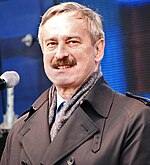Estonian parliamentary election, 1995
|
|
|||||||||||||||||||||||||||||||||||||
|---|---|---|---|---|---|---|---|---|---|---|---|---|---|---|---|---|---|---|---|---|---|---|---|---|---|---|---|---|---|---|---|---|---|---|---|---|---|
|
|||||||||||||||||||||||||||||||||||||
|
101 seats in the Riigikogu 51 seats were needed for a majority |
|||||||||||||||||||||||||||||||||||||
|
|||||||||||||||||||||||||||||||||||||
|
|||||||||||||||||||||||||||||||||||||
Parliamentary elections were held in Estonia on 5 March 1995. The governing parties were heavily defeated, except for the Reform Party, the successor of Estonian Liberal Democratic Party. The biggest winner was election cartel consisting of Coalition Party and its rural allies. The cartel won 41 seats which is the best result in Estonian parliamentary election so far.
Homeland National Coalition Party (Rahvuslik Koonderakond Isamaa) and Estonian National Independence Party formed an electoral cartel this time, nevertheless they got only eight seats in Riigikogu. Electoral list Right-wingers which included members of Fatherland splinter group Republicans’ and Conservatives’ People’s Party managed to pass the threshold with exactly 5% share of votes.
Social Democrats and Rural Centre Party presented a joined list again and soon after the election formed a new party called Moderates.
Election newcomer was Our Home is Estonia!, a Russian ethnic minority cartel. Among the lists that didn’t pass the threshold were a cartel known as the Fourth Power, formed consisting of the Royalists and Greens.
The defeat of the governing centre-right parties came as no surprise as the coalition parties had already been defeated in the 1993 local elections. The majority of the voters were disenchanted with coalition’s shock therapy policies and scandals which had already brought about the dismissal of Prime Minister Mart Laar. Laar’s premiership was also characterised with internal fights between coalition partners as well as different groups in his own Fatherland party. This led to a split in 1994, when several groups left Fatherland party.
After the election Coalition Party under the leadership of Tiit Vähi and the rural parties formed government coalition with the Estonian Centre Party, the government collapsed, however, as early as autumn 1995, after the so-called Tape scandal. As a consequence, the Centre party was replaced with Reform Party in the government. This coalition which suffered from internal disagreements and clashes between liberal Reform Party and centre-left rural parties ended in 1996, when Reform Party left the government. Coalition Party and its rural allies continued as minority government until the next regular election, March 1999.
...
Wikipedia



